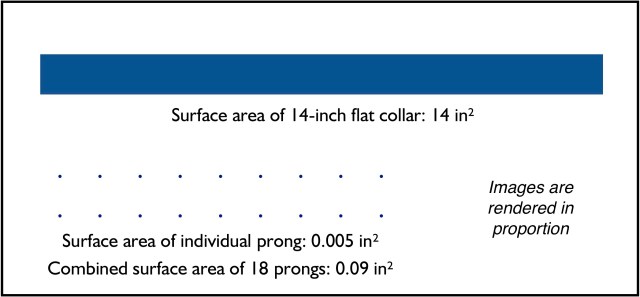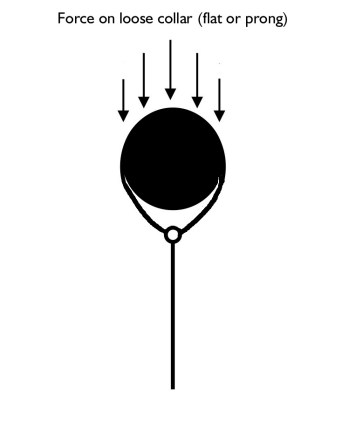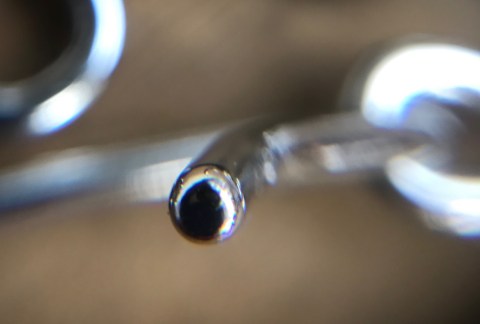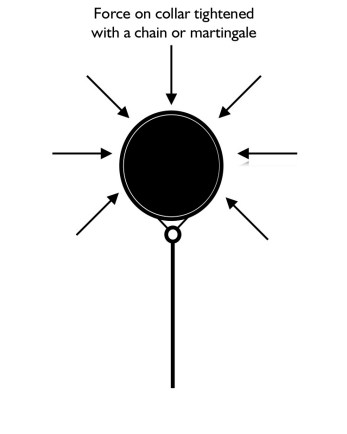Barks Blog
Why Prong Collars Hurt
Prong collars, also called pinch collars, are metal chain collars for dogs that include links of prongs whose ends press into the dog’s neck.
When a dog pulls on leash, moves out of position, or is “corrected” with a quick snap of the leash, force is exerted on the dog’s neck through the points of contact of the prongs.
Force is also exerted in these situations when the dog is wearing a flat collar. A correction applied to a dog on a flat collar can also be uncomfortable or even harm the dog.
But when we look at the physics, we can see why the prong collar is more uncomfortable, painful, and potentially damaging.
The differences between the pressure effects of a prong collar and a flat collar on a dog’s neck are due to the different surface areas. The prongs convey the same amount of force from pulling or a correction as the flat collar does, but the force is focused into a much smaller area.
We are aware of this intuitively every day. If you are walking barefoot through your house, would you rather step squarely on a Lego piece or a paperback book? Putting a good portion of your weight on a Lego piece hurts, even if the piece is not sharp enough to cut you. Why can you walk on top of the snow in snowshoes, but if you try it in spike heels they will punch through the snow and the rest of you will probably follow? Your weight is the same, but the force is concentrated.
Here’s why a prong collar works more like stiletto heels than like the webbing of a snowshoe.
Pressure is All About Surface Area
The prong collar I used to use has 18 prongs. 18 tiny round surfaces combined have a lot less surface area than a flat strip, but how much less?
Force applied to a surface is mathematically computed as pressure. A common way it is measured in the U.S. is in pounds per square inch, or PSI. (Technically the force unit is the pound-force or lbf, but people shorten it to pound for convenience.)
Example
I have a flat collar that is 14 inches long and 1 inch wide. Its area is 14.00″ x 1.00″ = 14.00 square inches.
The prong collar that I used on my dog in the past is also about 14 inches long, including 5 inches of chain that has no prongs but can be used to tighten the collar (see the top photo). The collar has 9 pairs of 2 prongs. They are placed over 8 inches of the collar. The ends of the prongs are about 0.08 inches in diameter (See the photo immediately above). They are smoothed in the manufacturing process so they aren’t sharp.
For a first approximation to compare the two, let’s compare the total surface areas of the two collars. We already know that the surface area of the flat collar is 14.00 in². (The abbreviation in² is read as “square inches.” The exponent doesn’t apply to the number preceding it.) To compute the combined surface area of the prongs we use the formula for the area of a circle (the end of each prong) and multiply that answer by 18 for the 18 prongs.
The area of a circle formula is πr². The radius is half the diameter of the end of the prong or 0.04 inches. So that’s
pi x (.04) x (.04) ≈ 0.005 in²
Multiply that by 18 to get the combined area of the 18 prongs and you get about 0.09 in².
Surface area of flat collar: 14.00 in²
Combined surface area of 18 prongs: 0.09 in²
Here’s an image that shows those areas in proportion. I drew it at half scale, making the flat collar 7 inches, but how big it renders on your computer will depend on all sorts of factors. The important thing is that the collar and the prongs are in proportion to each other at any size of the image.
 The respective surface areas mean that the flat collar has about 155 times the area of the prong collar.
The respective surface areas mean that the flat collar has about 155 times the area of the prong collar.
The corollary is that the same force applied to both collars causes 155 times more pressure on the prongs than on the flat collar.
In order to plug in a number for the force, I put harnesses on my dogs and experimented with an in-line scale. (They couldn’t believe I was asking them to pull!) Clara, 44 lbs, easily pulled up to 12 lbf and I know she can pull a lot harder, even on a flat collar rather than a harness. So let’s say a small-to-medium dog pulls at a force of 5 lbf. The force of 5 lbf spread over the 14 square inches of the flat collar yields 0.36 lbs per square inch (PSI). If you instead apply 5 lbf to the prong collar, you get 56 PSI.
Pressure on flat collar under 5 pounds of force: 0.36 pounds per square inch
Pressure on prong collar under 5 pounds of force: 56 pounds per square inch
This is a first approximation, but it’s pretty realistic. You can stop right here if you’d rather not get into the complexities. In most cases, the prong collar has about 155 times the pressure of the flat collar. In one situation described the disparity can be less, but the prong still has 50 times the pressure.
Two Scenarios
In our first approximation, I assumed that the force was applied equally to the entire area of the flat collar and equally to all 18 prongs. But this is not necessarily the case, depending on how the collar is fitted.
Loose Collar
If a flat collar or a prong collar is loose, the force will not distribute over the whole collar.
 You can see the unequal distribution of the force on a loose collar when a dog pulls. If the dog is pulling forward, most of the force is on the front of the collar, caused by the leash pulling backward. You may even see an area at the back of the dog’s neck where the collar is not touching the neck at all. Obviously, there is zero force from the collar applied there. This affects our pressure calculation since there is less surface area distributing the force over the dog’s neck. For purposes of a working estimate, let’s say that the actual area of the collar on which there is pressure when the dog pulls is the front quarter of the collar.
You can see the unequal distribution of the force on a loose collar when a dog pulls. If the dog is pulling forward, most of the force is on the front of the collar, caused by the leash pulling backward. You may even see an area at the back of the dog’s neck where the collar is not touching the neck at all. Obviously, there is zero force from the collar applied there. This affects our pressure calculation since there is less surface area distributing the force over the dog’s neck. For purposes of a working estimate, let’s say that the actual area of the collar on which there is pressure when the dog pulls is the front quarter of the collar.
This is an approximation for several reasons, one among them being that only in one spot of the dog’s neck is the force exactly normal to the arc of the neck. I have represented the differing force in part by the length of the arrows in the image. The force has the largest magnitude in the front and diminishes on the sides of the neck, finally going to zero. There are also smaller forces on the sides of the neck that I am not including. They are present on both collars.
For the 14-inch flat collar, let’s assume that for this approximation the force is distributed over the front 3.5 square inches of the collar. With one-quarter the area, you have four times the pressure. So the flat collar pressure in our example goes up to 1.44 PSI. But guess what? It’s the same situation on the prong collar. The force is distributed over fewer prongs. On my prong collar, it appears that the force would be distributed over 14 prongs rather than 18. (This is a generous estimate. Some of those prongs are barely touching the neck.) That raises the pressure on the prong, but not as large a raise as for the flat collar. But the pressure on the prong collar at 71.40 PSI is still 50 times that of the flat collar.
Tight Collar with Slip Chain/Martingale
Professional trainers who use prong collars do not fit them loosely around the neck. In the photo below, I have followed a professional’s instructions and fitted the prong in the closest approximation I can achieve on a stuffed toy. On a real dog, it would probably be even a bit higher and closer to the ears. (Also, some trainers put the leash attachment on the right side of the dog’s neck instead of the back so it is next to them when the dog is in heel position.)
First, note that the prongs are putting pressure on the neck without a force being applied by the leash. The force from the tight fit is roughly equivalent on all the prongs. We can emulate this setup with a tightly fitted flat collar. The comparison would be equivalent to our first example, with the pressure being about 155 times more per square inch on the prong collar.
In addition, the prong collar includes a slip chain. (You can see it in the top photo.) Depending on how the leash is connected to the chain, the handler can apply a snap of the leash—a “correction”—that can pull the ends of the collar together and further tighten the prongs. This force is also distributed over all the prongs. For a comparison, we could add a martingale to our tight flat collar. So for corrections as well, the pressure comparison would be the same as our first example: 155 times more pressure on the prong collar than on the flat martingale collar.
The tightly fitted prong collar is not an improvement for the dog, even though more of the prongs are touching the neck and the pressure is being distributed over more area. This is because the distribution adds another source of pressure, and also because the distribution still does not mitigate the disparities in contact areas between the two collars.
Because of the tight fit and the slip chain, there are three potential forces on the collar.
- The force applied by the tightness of the collar itself. Imagine tying a length of the cord around the calf of your leg, tightening it, and fastening it there. Without having to pull the leg in any direction, you’re exerting force.
- The directional force applied if the dog and trainer do not move similarly.
- The sudden, high magnitude force from corrections.
Please note that I am not advocating attaching a leash to a flat collar either. Harnesses are much safer. Even if the dog pulls, the force is distributed over an even larger area than a collar, and in less vulnerable places than the neck.
Conclusion
The math shown on this page includes approximations. The forces involved are actually vectors, and the pressures are not evenly distributed. However, both of these factors affect both types of collars. If you want to read more about these additional considerations, check out the prong collar appendix page. The page also has photos of the difference between placing an inert weight on my forearm and placing the same weight on a prong collar on my forearm, and a brief discussion of the spurious “proper fit of a prong collar” argument.
In all cases—even considering the complexities of the math— the pressure on the dog’s neck from by the prong collar is much, much greater than that created by the flat collar. The disparity in the surface areas makes that fact inescapable. The pressure on the prong collar is concentrated into multiple small areas (like spike heels) instead of being dispersed. And in my example, with blunted prongs of a medium size (you can obtain prongs that are smaller and sharper), the pressure is 155 times that caused by a flat collar.
That’s why prong collars hurt.
Thank you to my three pre-readers, who read for comprehensibility, for clear communication, and for the math. All errors and inaccuracies are my own.
Copyright 2017 Eileen Anderson





